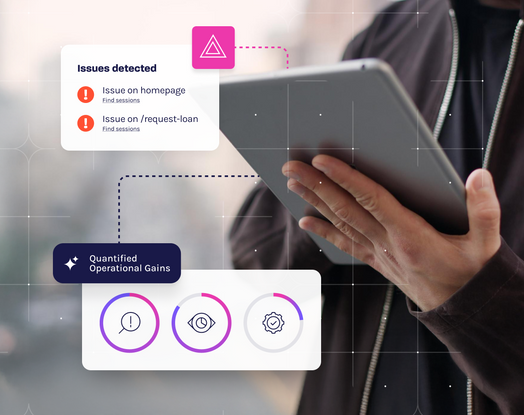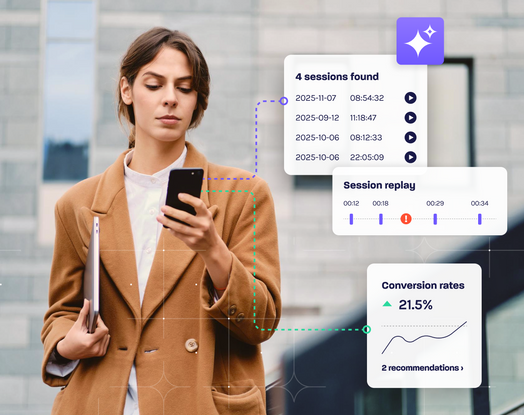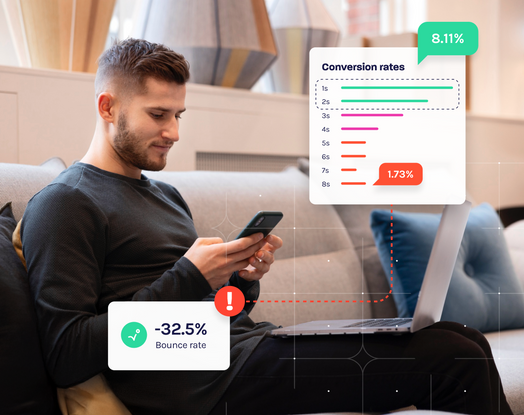
Customer Journey Optimization: Strategies for Every Touchpoint
Your customer journey is constantly evolving. This continuous process optimizes every stage of the customer journey to boost engagement, deepen loyalty and drive conversions.
While customer journey mapping identifies each step of a customer's journey, optimization transforms them. Instead of sketching touchpoints, customer journey optimization efforts remove friction, enhance satisfaction and turn interactions into revenue engines.
This guide provides a practical framework, key performance metrics and actionable tools to help improve customer experiences across digital channels and support touchpoints. Learn how to audit, segment, personalize and refine until every touchpoint exceeds expectations.
What Is Customer Journey Optimization?
Customer journey optimization improves every interaction, removes weaknesses and drives customer satisfaction alongside business performance. It doesn’t just record steps, it seizes control of the journey. By applying analytics and real-time insights, you eliminate friction, accelerate decisions and maximize value at every touchpoint.
Effective customer journey optimization combines customer journey analytics, predictive models and focused prioritization to turn the entire experience into a growth engine.
Customer Journey Optimization vs. Customer Journey Mapping
A customer journey map provides a snapshot of where customers go, what they feel and what obstacles block their path. While useful, it only tells part of the story. However, digital customer journey mapping lays the groundwork for optimization strategies.
Customer journey optimization goes further. It tests ideas, implements changes and measures results. Essentially, mapping identifies steps, whereas optimization improves their performance.
This improvement requires ongoing effort. Behavioral data, collaboration across teams and iterative refinements ensure your journey evolves with customer expectations. The payoff? A seamless experience across every channel that increase conversions, reduces churn and builds lifetime value.
Why Optimizing the Customer Journey Matters
Fragmented journeys lose customers. Why? Slow pages, confusing forms and inconsistent support drive people away. These friction points drain revenue, overwhelm support teams and damage trust. Optimized journeys flip this narrative.
Financial services leaders who prioritize customer journey management achieve measurable gains across the board, including:
Rising conversion rates resulting from streamlined processes that simplify decision-making
Lightened customer service workloads due to intuitive self-service options
Increased retention occurs when customers experience consistent value at every step
Improved satisfaction scores, which fuel loyalty and advocacy.
Consider the data, PwC reports that 73% of customers base their purchasing decisions on customer experience (CX). Building on this, S&P Global reports that companies leveraging digitally driven CX strategies consistently outperform peers, achieving higher median equity returns over time.
In competitive markets, journey optimization sets you apart. Superior onboarding reassures new customers, proactive insights suggest understanding and personalized experiences turn routine interactions into memorable moments. The question isn’t whether you can afford to optimize, but how quickly you can start.
How To Optimize the Customer Journey
A scattered approach doesn’t work. Follow this structured framework to turn customer data into meaningful action. These seven steps drive satisfaction, loyalty and revenue.
1. Assess Current Journey
Audit every interaction across your website, mobile app and support channels. Use session replays to uncover where users hesitate, click repeatedly or abandon tasks and use performance analytics to highlight slow load times and other conversion killers. Let data guide your next move instead of assumptions.
2. Segment Customers
Effective personalization begins with clear segmentation. Begin by identifying specific customer behavior, demographics, psychographics or lifecycle stage. A first-time visitor, a renewing policyholder and a high-value client require different approaches. Well-defined segments lay the foundation for targeted optimizations.
3. Map Touchpoints
Visualize the complete journey for each segment across digital, email, mobile and human support. Identify emotional highs and lows to align teams around shared goals. A clear journey map directs efforts to reduce customer effort and improve satisfaction.
4. Identify Friction and Drop-Off Points
Use funnel analysis, heatmaps and session replays to pinpoint blockers. Look for patterns such as:
Abandoned forms during key processes
Pages with load times over two seconds
Repeated support tickets for recurring issues
These insights reveal where optimization delivers the biggest impact.
5. Prioritize Fixes
Not all issues require immediate attention. Score each problem based on its impact on revenue, support volume and customer effort. Rally teams from CX, product, development and digital marketing around a unified backlog to focus resources on high-priority fixes.
6. Personalize the Experience
Leverage AI-driven recommendations, dynamic layouts and contextual messaging to adapt experiences in real time. Whether you use Adobe Journey Optimizer, Glassbox journey analytics or custom tools, aim to deliver the right message on the right channel at the perfect moment.
7. Monitor and Iterate
Optimization doesn’t end, it evolves. Track key metrics, run A/B tests, gather customer feedback and use anomaly detection to anticipate emerging issues. Each improvement builds on the last, creating a cycle of constant progress.
Choosing Which Part of the Journey To Optimize First
Focus on high-traffic or high-impact areas to see results quickly. Start with segments like product pages, checkout flows or onboarding processes, where improvements directly affect conversions and retention.
Prioritize analyzing these three factors:
Drop-off rates at specific touchpoints
Conversion potential where intent is high but completion is low
Support volume caused by recurring friction points
Link each optimization effort to clear business goals. For example, improve onboarding to boost retention or refine the homepage to enhance acquisition. Assign KPIs like conversion rate, engagement or lifetime value to measure success.
By tackling high-impact areas first, you prove the value of optimization and build momentum for broader initiatives. With priorities set, the next step is arming your team with the right tools.
Tools That Support Customer Journey Optimization
The right tools turn data into action. When evaluating solutions, focus on features that enable immediate, measurable improvements:
Cross-platform data capture across web, mobile and support
Real-time analytics to catch issues before they escalate
Behavior tracking without manual tagging
Automated anomaly detection to flag hidden problems
Visual journey analysis to align teams with shared insights
Traditional platforms like Google Analytics or Adobe Analytics provide basic data, but specialized tools like Glassbox go further. Glassbox records every session, replays user behavior and uses AI to uncover friction points and hear from silent users. Features like tagless data capture and funnel analysis eliminate blind spots and streamline implementation.
These advanced capabilities define the "journey optimizer" category. Designed for real-time orchestration and personalization, these tools empower teams to act quickly and decisively. The next step involves measuring success.
Metrics To Measure Optimization Success
Optimization relies on measurable outcomes. By tracking customer experience and business metrics, you can evaluate both sentiment and revenue impact.
Key customer-facing metrics include:
Customer Satisfaction Score
Net Promoter Score
Session completion rate
Bounce rate
Business metrics to monitor:
Conversion rate
Customer Lifetime Value
Support tickets deflected
Establish baselines before starting any initiative to measure progress effectively. Use these benchmarks to quantify improvements and refine your strategy. Insights only matter when they drive action, so ensure teams act on findings to deliver tangible results.
Customer Journey Optimization in Action: Real-World Examples
Here’s how leading organizations are transforming friction into success:
Finance
SoFi utilized Glassbox's digital experience analytics to proactively identify and resolve user experience issues, preventing potential revenue losses of up to $9 million. By monitoring user interactions and swiftly addressing friction points, SoFi enhanced its digital loan application process, leading to increased customer satisfaction and conversion rates.
Retail
Leading pharmacy retailer Chemist Warehouse leveraged Glassbox's insights to optimize its online shopping experience. Through detailed analysis of user behavior and customer pain points, the company implemented changes that resulted in a 9% increase in conversion rates, demonstrating better results that stem from data-driven decision-making on e-commerce performance.
Telecommunications
A major U.S. no-contract mobile provider faced a surge in customer complaints about unusable promo codes during checkout. By integrating Glassbox with their Qualtrics survey data, the analytics team quickly identified that customers were receiving expired promo codes. Utilizing session replays and funnel analysis, they reproduced the issue, assessed its impact—over $10,000 in lost sales in a week—and implemented a fix. Within a week, the error rate decreased sixfold, saving over $500,000 in potential annual sales. Additionally, they set up real-time alerts to monitor and prevent future occurrences.
Travel and hospitality
Marriott utilized Glassbox's digital experience analytics to identify and swiftly resolve a common issue affecting thousands of customers during account activation and login. This proactive approach led to a 60% decrease in support requests and improved digital access for 141 million customers.
Insurance
By integrating Glassbox's session replay and call listening tools, An Post Insurance identified and addressed customer confusion points in their online quote process. Simple adjustments, such as rewording questions and adding help text, led to a 6% increase in conversion rates and a reduction in call center inquiries.
Each successful customer journey optimization began with journey analytics, cross-functional collaboration and relentless iteration.
Turn Customer Journeys Into Growth Engines
Customer journey optimization drives measurable outcomes, including higher conversions, deeper customer loyalty and greater lifetime value. Every optimized customer touchpoint contributes to business growth.
Glassbox equips you with the tools to make this happen. Our tagless data capture, AI-powered insights and collaborative dashboards turn opaque journeys into actionable opportunities. Deliver smarter experiences, act faster and keep customers satisfied.
With Glassbox, you can leverage AI for CX insights and own your customer journey. Deliver results that matter. Explore our Customer Journey Mapping Guide to find out how to turn every interaction into a competitive advantage.







